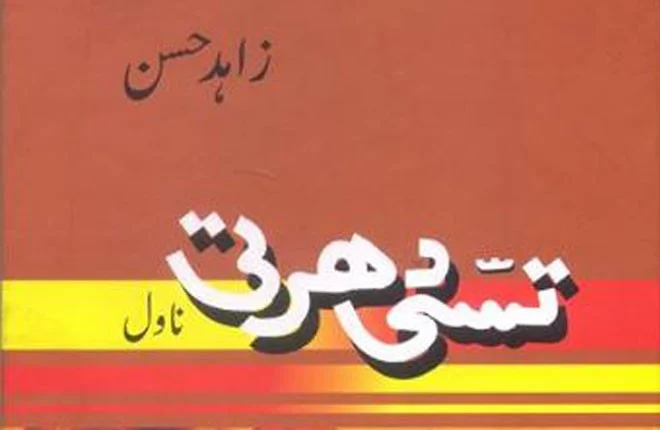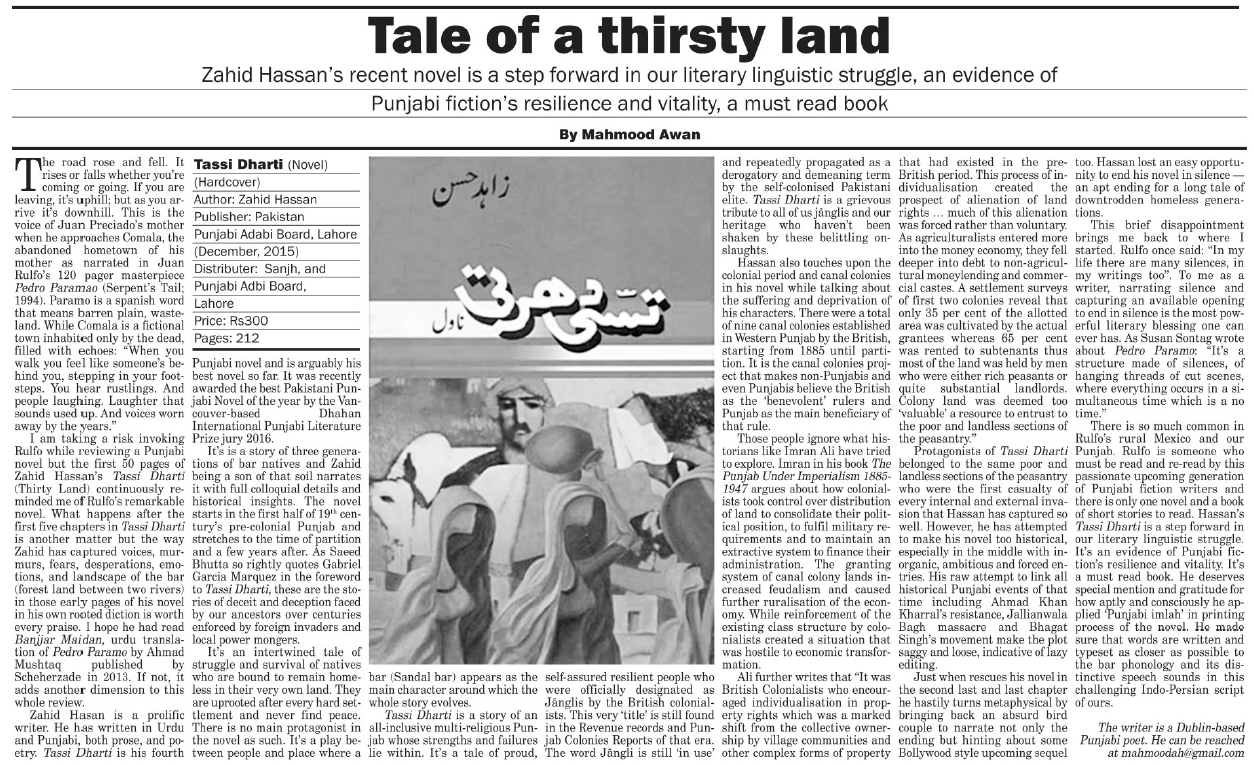Mahmood Awan (The News on Sunday, 18th December 2016)
The road rose and fell. It rises or falls whether you’re coming or going. If you are leaving, it’s uphill; but as you arrive it’s downhill. This is the voice of Juan Preciado’s mother when he approaches Comala, the abandoned hometown of his mother as narrated in Juan Rulfo’s 120 pager masterpiece Pedro Paramao (Serpent’s Tail; 1994). Paramo is a spanish word that means barren plain, wasteland. While Comala is a fictional town inhabited only by the dead, filled with echoes: “When you walk you feel like someone’s behind you, stepping in your footsteps. You hear rustlings. And people laughing. Laughter that sounds used up. And voices worn away by the years.”
I am taking a risk invoking Rulfo while reviewing a Punjabi novel but the first 50 pages of Zahid Hassan’s Tassi Dharti (Thirty Land) continuously reminded me of Rulfo’s remarkable novel. What happens after the first five chapters in Tassi Dharti is another matter but the way Zahid has captured voices, murmurs, fears, desperations, emotions, and landscape of the bar (forest land between two rivers) in those early pages of his novel in his own rooted diction is worth every praise. I hope he had read Banjjar Maidan, urdu translation of Pedro Paramo by Ahmad Mushtaq published by Scheherzade in 2013. If not, it adds another dimension to this whole review.
Zahid Hasan is a prolific writer. He has written in Urdu and Punjabi, both prose, and poetry. Tassi Dharti is his fourth Punjabi novel and is arguably his best novel so far. It was recently awarded the best Pakistani Punjabi Novel of the year by the Vancouver-based Dhahan International Punjabi Literature Prize jury 2016.
It’s is a story of three generations of bar natives and Zahid being a son of that soil narrates it with full colloquial details and historical insights. The novel starts in the first half of 19th century’s pre-colonial Punjab and stretches to the time of partition and a few years after. As Saeed Bhutta so rightly quotes Gabriel Garcia Marquez in the foreword to Tassi Dharti, these are the stories of deceit and deception faced by our ancestors over centuries enforced by foreign invaders and local power mongers.
It’s an intertwined tale of struggle and survival of natives who are bound to remain homeless in their very own land. They are uprooted after every hard settlement and never find peace. There is no main protagonist in the novel as such. It’s a play between people and place where a bar (Sandal bar) appears as the main character around which the whole story evolves.
Tassi Dharti is a story of an all-inclusive multi-religious Punjab whose strengths and failures lie within. It’s a tale of proud, self-assured resilient people who were officially designated as Jãnglis by the British colonialists. This very ‘title’ is still found in the Revenue records and Punjab Colonies Reports of that era. The word Jãngli is still ‘in use’ and repeatedly propagated as a derogatory and demeaning term by the self-colonised Pakistani elite. Tassi Dharti is a grievous tribute to all of us jãnglis and our heritage who haven’t been shaken by these belittling onslaughts.
Hassan also touches upon the colonial period and canal colonies in his novel while talking about the suffering and deprivation of his characters. There were a total of nine canal colonies established in Western Punjab by the British, starting from 1885 until partition. It is the canal colonies project that makes non-Punjabis and even Punjabis believe the British as the ‘benevolent’ rulers and Punjab as the main beneficiary of that rule.
Those people ignore what historians like Imran Ali have tried to explore. Imran in his book The Punjab Under Imperialism 1885-1947 argues about how colonialists took control over distribution of land to consolidate their political position, to fulfil military requirements and to maintain an extractive system to finance their administration. The granting system of canal colony lands increased feudalism and caused further ruralisation of the economy. While reinforcement of the existing class structure by colonialists created a situation that was hostile to economic transformation.
Ali further writes that “It was British Colonialists who encouraged individualisation in property rights which was a marked shift from the collective ownership by village communities and other complex forms of property that had existed in the pre-British period. This process of individualisation created the prospect of alienation of land rights … much of this alienation was forced rather than voluntary. As agriculturalists entered more into the money economy, they fell deeper into debt to non-agricultural moneylending and commercial castes. A settlement surveys of first two colonies reveal that only 35 per cent of the allotted area was cultivated by the actual grantees whereas 65 per cent was rented to subtenants thus most of the land was held by men who were either rich peasants or quite substantial landlords. Colony land was deemed too ‘valuable’ a resource to entrust to the poor and landless sections of the peasantry.”
Protagonists of Tassi Dharti belonged to the same poor and landless sections of the peasantry who were the first casualty of every internal and external invasion that Hassan has captured so well. However, he has attempted to make his novel too historical, especially in the middle with inorganic, ambitious and forced entries. His raw attempt to link all historical Punjabi events of that time including Ahmad Khan Kharral’s resistance, Jallianwala Bagh massacre and Bhagat Singh’s movement make the plot saggy and loose, indicative of lazy editing.
Just when Hassan rescues his novel in the second last and last chapter he hastily turns metaphysical by bringing back an absurd bird couple to narrate not only the ending but hinting about some Bollywood style upcoming sequel too. Hassan lost an easy opportunity to end his novel in silence — an apt ending for a long tale of downtrodden homeless generations.
This brief disappointment brings me back to where I started. Rulfo once said: “In my life there are many silences, in my writings too”. To me as a writer, narrating silence and capturing an available opening to end in silence is the most powerful literary blessing one can ever has. As Susan Sontag wrote about Pedro Paramo: “It’s a structure made of silences, of hanging threads of cut scenes, where everything occurs in a simultaneous time which is a no time.”
There is so much common in Rulfo’s rural Mexico and our Punjab. Rulfo is someone who must be read and re-read by this passionate upcoming generation of Punjabi fiction writers and there is only one novel and a book of short stories to read. Hassan’s Tassi Dharti is a step forward in our literary linguistic struggle. It’s an evidence of Punjabi fiction’s resilience and vitality. It’s a must read book. He deserves special mention and gratitude for how aptly and consciously he applied ‘Punjabi imlah’ in printing process of the novel. He made sure that words are written and typeset as closer as possible to the bar phonology and its distinctive speech sounds in this challenging Indo-Persian script of ours.
Tassi Dharti (Novel) (Hardcover)
Author: Zahid Hassan
Publisher: Pakistan Punjabi Adabi Board, Lahore (December, 2015)
Distributer: Sanjh, and Punjabi Adbi Board, Lahore
Price: Rs300
Pages: 212
Published on 18th December 2016 in The News on Sunday.
https://www.thenews.com.pk/tns/detail/562320-tale-thirsty-land


